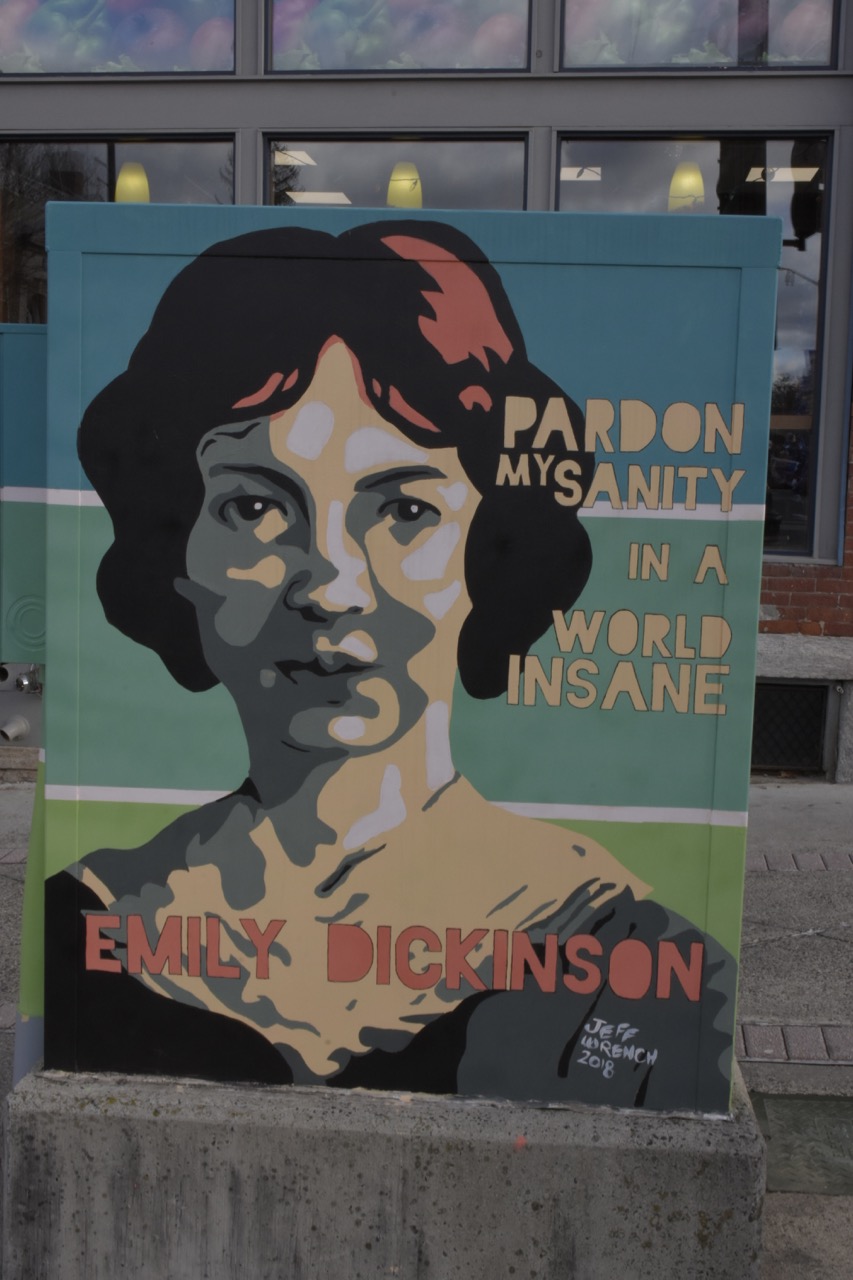A SPECIAL REPORT ON AMHERST’S PERCENT FOR ART BYLAW

Public art from downtown Amherst featuring an homage to Emily Dickinson. Photo: Art Keene
Editor’s Note: This commentary also appeared in the Amherst Bulletin on 7/25/19.
Town Meeting passed the Percent for Art Bylaw on May 5, 2017 with a vote of 110-45-7. Over two years later, it still hasn’t been enacted and is in danger of being eliminated by Town Council. The bylaw, which was proposed by the Amherst Public Art Commission, stipulates that money be included in town capital improvement projects budgeted over $100,000 for public art. Money generated by the bylaw would be used for on-site art works as well supporting the performing arts and the upkeep of existing town-owned artworks.
A piece of the bylaw concerning funding needed state approval before it could take effect. Over the course of 2018, it was approved by the House and was making its way through the Senate when an attorney working for the Department of Revenue raised several questions. Amherst’s town manager and council failed to respond before the end of the legislative session, casting the bylaw into limbo. The council now has the authority to decide its fate and has as yet shown little support. The bylaw will be triggered by the four big capital improvement projects that they will address this fall, giving its passage a sense of urgency.
Percent for Art programs began in the Great Depression when the Treasury Department hired artists to decorate public buildings. Post offices were one of the prime beneficiaries of this work, including several here in the Pioneer Valley. In 1963, the Federal Art in Architecture program began mandating that one half of one percent of all federal building projects be used for on-site art. Similar programs have proliferated at the state and local levels. Philadelphia was the first city in the country to launch one and now has more publicly funded art than anywhere in the world. Today, these programs are found in big cities and small towns. Americans for the Arts reports that of the 350 public art programs in the U.S., 111 serve populations of 150,000 or less.
Public art is any art that is open to everyone, typically for free. Prototypical works of public art are town-square monuments like Michelangelo’s David or, on the Boston common, Augustus Saint-Gaudens’ memorial to Robert Gould Shaw who lead one of the first all-black regiments in the Civil War. The best-known recent example of public art is Anish Kapoor’s Cloud Gate, a gigantic, bean-shaped chrome arch that has helped transformed Chicago’s old rail yards into one of the world’s premier tourist destinations.
Public art is a significant part of creative placemaking, a movement that aims to shape towns around art works and cultural activities in order to enliven streetscapes, attract visitors and gather people together to be inspired, celebrate and empathetically engage with each other and big ideas. I’ve spent all of my life in places shaped by creative placemaking and seen its effects first hand. To see how well it works, one need only to look to Northampton and Easthampton, whose support for the arts has turned them into exciting places to live, work and visit.
Amherst’s Percent for Art bylaw is a way to attract not only great art but also the money that accompanies it. The Mass Cultural Council recently reported that three out of four Massachusetts residents participate in at least one cultural event each month. They write that art-related institutions in the state directly generate $97 million per year and as a whole have a $2.3 billion dollar yearly economic impact on the state. The National Governors Association singles out Percent for Art programs as a tool that towns can use to aid economic development because they offer both employment opportunities and contribute to quality of life. They also diversify access to the arts by bring them to a broader economic spectrum of people.
Amherst’s previous finance director, Sandy Pooler, estimated that the Percent for Art bylaw would cost each town resident less than a single cup of coffee per year. Councilor Andy Steinberg, who is the chair of the Finance Committee, has recently said in an email that he might withdraw his support for the bylaw. One of the reasons he cited was the rising cost of the proposed elementary school project, which he estimated at $80 million. Nevertheless, Steinberg said he agrees with Pooler’s numbers. Using a combination of Pooler and Steinberg’s numbers, if the town’s portion of this project is $40 million, which it pays for with a 25-year bond at 4.5% interest, then the average additional cost to taxpayers over the life of the loan will be $1.89 per year.
In the run-up to the council election, members of Amherst Arts Night sent a survey to all of the candidates. Every single candidate said they supported the arts and recognized that the arts contribute to Amherst’s economic and cultural well-being. Councilors need to decide not only if they value the arts, but if they are willing to commit town money to support them. I understand that there are many pressing, compelling and competing needs in town. I am only asking that the arts be given the same timely consideration.

1 thought on “A SPECIAL REPORT ON AMHERST’S PERCENT FOR ART BYLAW”